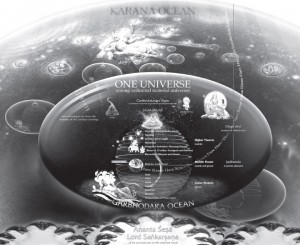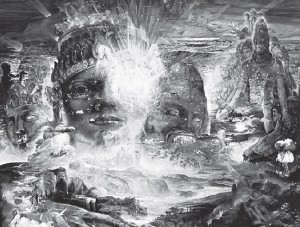Spanning across the eighteen chapters of this great classic are these important subjects that Lord Krishna focuses upon.
The subject of the Bhagavad-gita entails the comprehension of five basic truths. First of all, the science of God is explained and then the constitutional position of the living entities, jivas. There is ishvara, which means the controller, and there are jivas, the living entities which are controlled. If a living entity says that he is not controlled but that he is free, then he is insane. The living being is controlled in every respect, at least in his conditioned life. So in the Bhagavad-gita the subject matter deals with the ishvara, the supreme controller, and the jivas, the controlled living entities. Prekiti (material nature) and time (the duration of existence of the whole universe or the manifestation of material nature) and karma (activity) are also discussed. The cosmic manifestation is full of different activities. All living entities are engaged in different activities. From Bhagavad-gita we must learn what God is, what the living entities are, what prakriti is, what the cosmic manifestation is, how it is controlled by time, and what the activities of the living entities are …. of the five items (ishvara, jivas, prakriti, time and karma) four are eternal, whereas karma is not eternal.- Introduction to Bhagavad-gita As It Is
To understand Krishna means to understand the whole cosmic manifestation, God, the material nature, the time factor, the living entities, their respective relationship, everything. That is called samagram. – Lecture on Bhagavad-gita 7.1- 3, Ahmedabad, December 14, 1972
1. Ishvara, God : The Supreme Godhead, or Krishna, or Brahman, or the supreme controller, or Paramatma you may use whatever name you like is the greatest of all. . . When we see wonderful things happening in the cosmic nature, we should know that behind this cosmic manifestation there is a controller. Nothing could be manifested without being controlled. It is childish not to consider the controller. For instance, a child may think that an automobile is quite wonderful to be able to run without a horse or other animal pulling it, but a sane man knows the nature of the automobile's engineering arrange-ment. He always knows that behind the machinery there is a man, a driver. Similarly, the Supreme Lord is the driver under whose direction everything is working. – Introduction to Bhagavad-gita As It Is
Krishna is the Supreme enjoyer. We are trying to become imitation Krishna, Just like so many rascals, they declare that "God, I am God." – Lecture on Bhagavad-gita 1.13-14, London, July 14, 1973
2. jiva, living entity : Now the jivas, or the living entities, have been accepted by the Lord, as we will note in the later chapters, as His parts and parcels. A particle of gold is also gold, a drop of water from the ocean is also salty, and similarly we the living entities, being part and parcel of the supreme controller, ishvara, or Bhagavan, Lord Sri Krishna, have all the qualities of the Supreme Lord in minute quantity because we are minute ishvaras, subordinate ishvaras. We are trying to control nature, as presently we are trying to control space or planets, and this tendency to control is there because it is in Krishna, But although we have a tendency to lord it over material nature, we should know that we are not the supreme controller. – Introduction to Bhagavad-gita As It Is
The living spark, the soul, is the same dimension, either within the ant or in the elephant. This dimension of the soul we have several times discussed, 1/10,000th part of the top of the hair. Kesagra-satabhagasya satadha kalpitasya ca/ jivo bhagahl sa vijneyah/ sa canantyaya kalpate [Cc. Madhya 19.140] That is the dimension. In shastra we get the dimension of the soul-very, very minute: 1/10,000th part of the top of the hair. Just imagine. So that portion is within the ant and within Brahma and within elephant. – Lecture on Bhagavad-gita 1.44, London, July 31, 1973
3. Prakriti, material nature : The manifestation of the world is not accepted as false; it is accepted as real, but temporary. It is likened unto a cloud which moves across the sky, or the coming of the rainy season, which nourishes grains. As soon as the rainy season is over and as soon as the cloud goes away, all the crops which were nourished by the rain dry up. Similarly, this material manifestation takes place at a certain interval, stays for a while and then disappears. Such are the workings of prakriti. But this cycle is working eternally. Therefore prakriti is eternal; it is not false. The Lord Nothing could be manifested without being controlled. It is childish not to consider the controller. refers to this as "My prakriti." This material nature is the separated energy of the Supreme Lord … – Introduction to Bhagavad-gita As It Is
What is material nature? This is also explained in gita as inferior prakriti, inferior nature … Prekiti is always under control, whether inferior or superior. Prakriti is female, and she is controlled by the Lord just as the activities of a wife are controlled by the husband. Prakriti is always subordinate, predominated by the Lord, who is the predominator. . . Material nature itself is constituted by three qualities: the mode of goodness, the mode of passion and the mode of ignorance. – Introduction to Bhagavad-gita As It Is
4. Kala, time factor : Kalena mahata. By the great power. Kala means time. Time has got his influence, very great influence. Time's business is, whatever you make, time will try to kill you. That's all. You make a nice house, very nice house, but as soon as it becomes older it is being killed. You have very good body, nice body, but the influence of time is trying to kill you. That is the influence of time. So in the Bhagavad-gita you'll also find that
when Arjuna saw the universal form of Krishna, he asked that "Who are You?" And Krishna said in that universal form that "I am Kala. I have come to kill" That's it. This was the answer.
So kala's business is to kill. So here also it is said sa kalena iha, kalena mahata. Mahata is also karana, and kalena, by the influence of…, that is now lost. Because it is a struggle. Our struggle for existence means we are trying to exist, but kala is fighting to kill. That is going on. So kala's business, time's business is to kill, but that system is now lost, is now killed by the influence of time. – Lecture on Bhagavad-gita 4.1, Montreal, August 24, 1968
Pradyumna: What kind of manifestation is time, of Krishna, kala? Kala, time. How is time a feature of Krishna?
Prabhupada: Time has no influence over Krishna,
Pradyumna: But time is a feature of Krishna, a manifestation of Krishna?
Prabhupada: Everything is feature of Krishna, so time is naturally a feature of Krishna,
Pradyumna: If we measure time in this world by our material bodies and yet there is no time in the spiritual sky, but there is difference of type.
Prabhupada: No. The time influence is not there. Time is eternal. But here the influence of time is acting. Just like this table is new, but by the influ-ence of time it will gradually become old … . Every potency of Krishna is there, but their activities, as we find here in this material world, they are not there. – Lecture on Bhagavad-gita 4.1, Montreal, August 24, 1968
5. Karma, activities: The effects of karma may be very old indeed. We are suffering or enjoying the results of our activities from time immemorial, but we can change the results of our karma, or our activity, and this change depends on the perfection of our knowledge. We are engaged in various activities. Undoubtedly we do not know what sort of activities we should adopt to gain relief from the actions and reactions of all these activities, but this is also explained in the Bhagavad-gita. – Introduction to Bhagavad-gita As It Is.
When the living entity is in material consciousness, he has to take on various bodies in the material world. That is called karma, or varied creation by the force of material consciousness …. According to his identification with material or spiritual nature, he receives a material or spiritual body. In material nature he may take a body from any of the 8,400,000 species of life, but in spiritual nature he has only one body. In material nature he is manifested sometimes as a man, demigod, animal, beast, bird, etc., according to his karma. To attain material heavenly planets and enjoy their facilities, he sometimes performs sacrifices (yajna), but when his merit is exhausted he returns to earth again in the form of a man. This process is called karma. – Bhagavad-gita 8.3, purport
The Two Prakritis
Both the living entity and material nature are explained as prakriti, the energy of the Supreme Lord, but one of the two, the jivas, is conscious. The other prakti is not conscious. That is the difference. Therefore the jivas-prakti is called superior because the jivas has consciousness which is similar to the Lord's. –Introduction to Bhagavad-gita As It Is
These eight types of material nature-earth, water, fire, air, sky, mind, intelligence and ego-these are material nature. Bhinna prakritir astadha. They are separated energies. Apareyam itas tu viddhi me prakritim periim. Beyond this. These are inferior, apara. And beyond this apara-Prakriti, there is another, superior prakriti. What is that? jivas-bhutam maha-baho yayedam dharyate jagat [Bg. 7.5]. That is the living entity. – Lecture on Bhagavad-gita 2.13, Hyderabad, November 18, 1972
God and the Living Entity-are they One or Different? : The distinction between the jivas and the ishvara will be ex- plained in the Thirteenth Chapter of Bhagavad-gita. The Lord is kshetra-jna, conscious, as is the living being, but the living being is conscious of his particular body, whereas the Lord is conscious of all bodies. Because He lives in the heart of every living being, He is conscious of the psychic movements of the particular jivas. We should not forget this. It is also explained that the Paramatma, the Supreme Personality of Godhead, is living in everyone's heart as ishvara, as the controller, and that He is giving directions for the living entity to act as he desires. – Introduction to Bhagavad-gita As It Is
The supreme conscious ishvara is similar to the living entity in this way: both the consciousness of the Lord and that of the living entity are transcendental. It is not that consciousness is generated by the association of matter. . . When He descends into the material universe, His consciousness is not materially affected … Our consciousness, at the present moment, however, is materially contaminated. – Introduction to Bhagavad-gita As It Is
Krishna says, aharh bija-pradah pita [gita 14.4], "I am the original father of all living entities." So if God is father of all living entities and we all living entities, we are individual person, how God can be imperson? God is person. – Lecture on Bhagavad-gita 2.11, Edinburgh July 16, 1972


